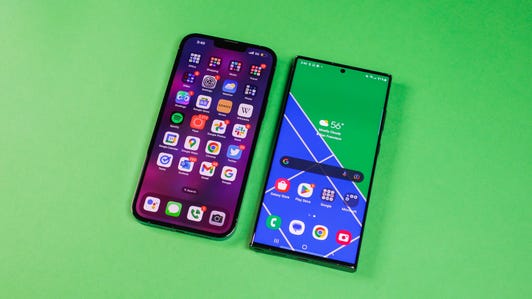Technologies
iPhone 14 Pro vs. Galaxy S23 Ultra: This Ex-Android Lover Has Thoughts
Do I regret switching to Apple?
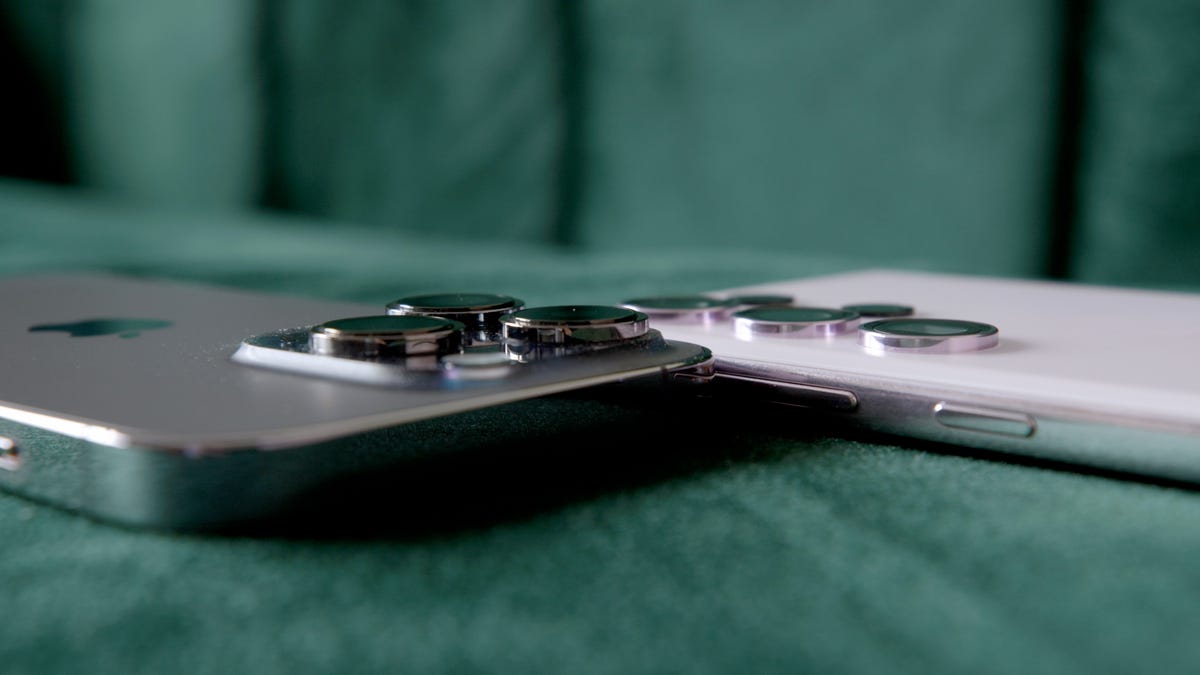
This story is part of Samsung Event, CNET’s collection of news, tips and advice around Samsung’s most popular products.
Five months ago, I went from being a die-hard Samsung Galaxy fan to a sellout iPhone owner. Since then, I’ve fully adapted to the world of Apple and have been basking in the perks of features like AirDrop and iMessage (mostly to the delight of my friends, who were sick of my green texts).
But I still have a soft spot for Galaxy phones, and when Samsung unveiled the S23 lineup in February, I was eager to see how the top-of-the-line S23 Ultra would compare to my iPhone 14 Pro. So I got my hands on one and began using the phones side by side to compare everything from the cameras to battery life to overall design — and to see whether I’d have any regrets about switching to the «dark side.» Here’s what I found.
The Galaxy S23 Ultra’s display vs. Apple’s Super Retina screen
First things first: I have an iPhone 14 Pro, and not a Pro Max, so the Ultra’s massive screen definitely stands out in comparison. I never feel like I need a bigger screen than what I get on my 14 Pro, but it definitely doesn’t hurt to have that larger display when I’m watching a YouTube video or streaming a show — or spending too much time on TikTok.
The trade-off to having that larger screen is trying to fit it in my pocket and having to carry something a bit bulkier. Still, it’s a pretty sleek phone for all that real estate.
The display quality on both phones is stellar, and I don’t see much of a quality difference between the two. Right out of the box, the S23 Ultra has a nice bright display, which you can achieve on the iPhone by turning off True Tone (a feature that adjusts the color and intensity of your display depending on your environment). If the brightness on the Ultra is too much, you can inversely mimic the effects of True Tone by going into Display settings and either toggling on Eye comfort shield or going to Screen mode and selecting Natural. You can also play with the White balance scale. Images on the iPhone look slightly sharper, but colors pop a bit more on the S23 Ultra. Overall, though, there’s really not much of a difference between the phones.

The keyboard on the Galaxy S23 Ultra (right) places numbers above letters, so you don’t have to hop between the two.
John Kim/CNETThere’s one aspect to having an iPhone that I haven’t quite made peace with yet, and it’s the keyboard. I’m glad Apple added Slide to Type with iOS 13 a few years ago, followed by haptic feedback on the keyboard with iOS 16 (finally), because those are features I loved on Android. But I still get frustrated that I have to switch between numbers and letters when I’m typing on the iPhone. Meanwhile, on the Galaxy, the numbers sit just above the letters, so you can select them more quickly, the way you would on a laptop keyboard. You can download different keyboards on the iPhone like Gboard, but it’s not the same. I’ll admit that’s a minor complaint, but I do think the user experience would benefit from Apple taking a page from Android’s book — you know, like they’ve done many times before. Moving on….
The Galaxy S23 Ultra’s battery life is next level
I’ve had my iPhone for a few months now and thankfully haven’t seen any noticeable drops in battery life yet. My phone still lasts a full day of heavy use, but I always need to charge at the end of the day.
The Ultra’s battery is next level. I can go a full day of use and still have some juice left over. That’s not surprising, given the S23 Ultra has a 5,000-mAh battery. Apple doesn’t share battery capacity for its phones, but says the 14 Pro has up to 23 hours of video playback. An iFixit teardown found the iPhone 14 Pro has a 3,200-mAh battery.
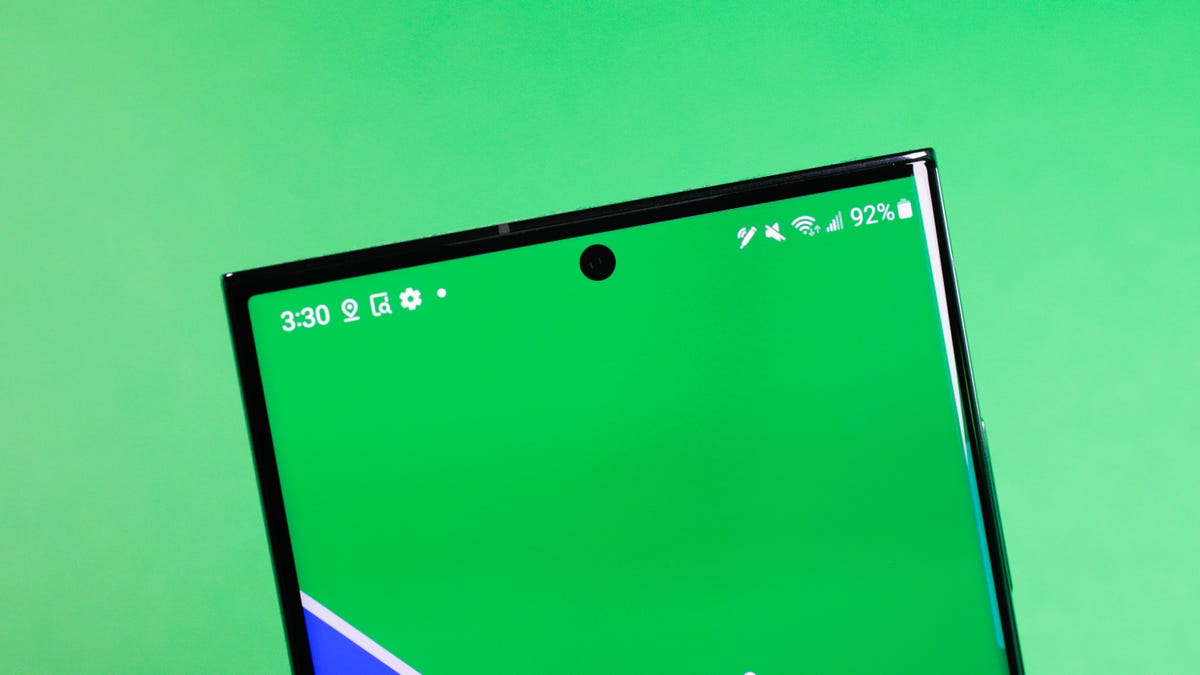

The battery that keeps going.
James Martin/CNETEven though the Ultra has a bigger battery, Apple is actually able to crank out more efficiency from its batteries thanks to iOS and its own A-series chips. Meanwhile, Android has to work with a variety of devices running different processors, so it becomes more important to have that bigger battery.
Specs and logistics aside, I’m amazed by the Ultra’s battery life, as was CNET’s mobile reporter Lisa Eadicicco when she reviewed the Ultra.
The S23 Ultra’s 200-megapixel camera
Camera quality is the most important aspect of any phone for me. I take a lot of pictures and videos for work and social media, including for my very niche tea account on Instagram. The camera on the Galaxy phones kept me in the Samsung family for a decade, so I was eager to compare the S23 Ultra’s cameras to the iPhone 14 Pro’s.
What I noticed right away is how much more saturated photos on the Ultra are. In most cases, that saturation adds a nice color boost to images and makes them stand out more. Pictures of my colorful teacups look even more vibrant on the Ultra. Sometimes, that saturation can be a bit overwhelming and makes photos look unnatural, as if there’s a filter on them. But other times, it makes colors and subjects stand out, in a good way.


The Galaxy S23 Ultra’s 200-megapixel sensor brings out details and color in this decorative teacup.
Abrar Al-Heeti/CNETThe 200-megapixel sensor on the Ultra punches up color and detail even more. A picture I took of a decorative teacup emphasizes the intricate floral design and gold trim and another image of a Klay Thompson mural shows vivid blues and yellows.
Not all moments are made for a 200-megapixel sensor, though. In another image taken outdoors, the sensor removed a few too many highlights, so it was harder to see detail and make sense of what’s going on.
Overall, I appreciate the softness and brightness of photos on the Ultra. Shadows on the iPhone are often a bit too harsh and give some images a darker overtone. An image of the sky on the Ultra will look nice and bright, while on the iPhone, there might be distracting shadows under clouds. The Ultra’s softness and brightness also make for more flattering selfies. You can adjust the iPhone’s camera settings and play around with things like contrast, tone and color temperature, and even mimic photography styles on the Galaxy (and vice versa), but I do wish the iPhone just automatically adjusted for things like shadows a little better.
The camera feature that surprised me most was Portrait mode. I think of Portrait mode on the iPhone as the gold standard. The subject is usually in perfect focus, the background is smoothly blurred and the colors are more natural looking. But I noticed there’s something the Ultra did better than my iPhone. I took a picture of my friend while she had sunglasses on top of her head, and the iPhone struggled to keep the bridge and sides of the glasses in focus, while the Ultra didn’t. It’s that small detail that shows how far Portrait mode has come on Galaxy phones. I still prefer the look of iPhone portraits because of the lower saturation, and you can catch a bit more detail in the background, which is nice.
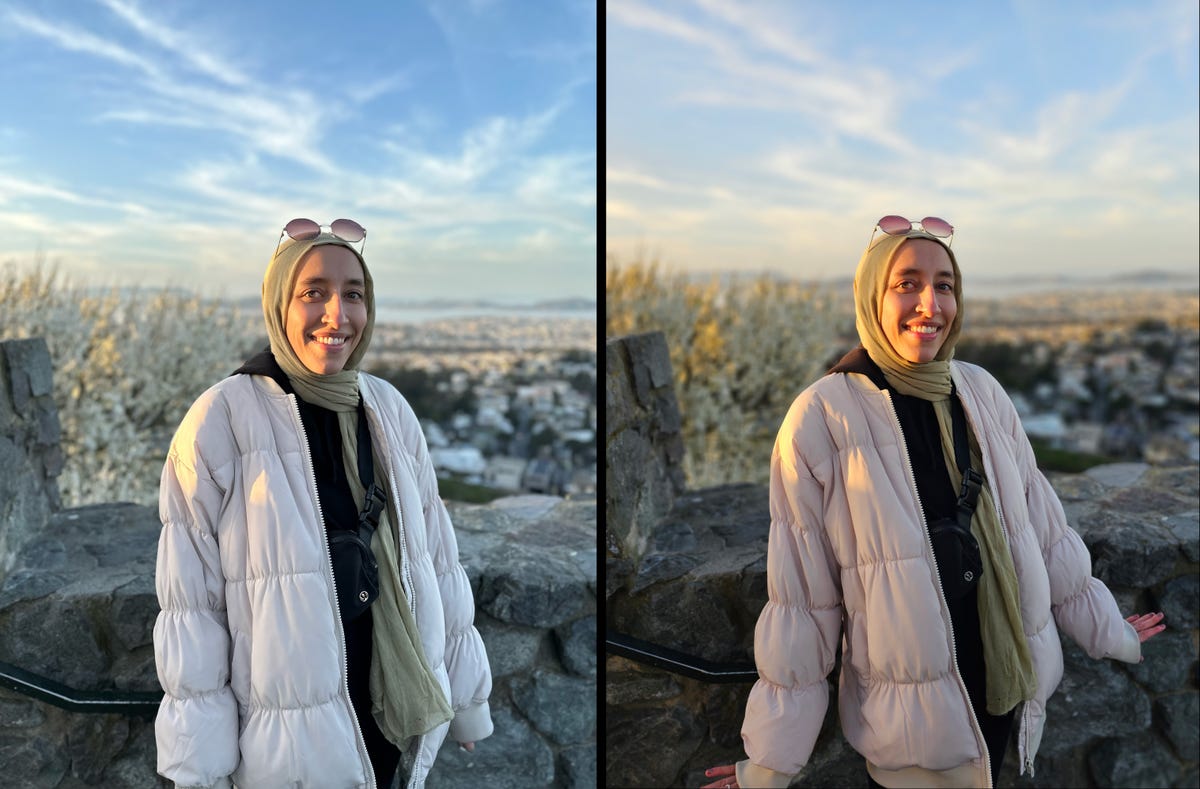

The picture on the left was taken with Portrait mode on the iPhone 14 Pro, while the one on the right was taken with the Galaxy S23 Ultra. If you look closely, you’ll nice the iPhone blurs the bridge and sides of the glasses, while the Ultra doesn’t.
Abrar Al-Heeti/CNETDoes the Galaxy S23 Ultra beat the iPhone at video?
Given the popularity of TikTok and Instagram Reels right now, video is a huge focus for both Apple and Samsung — and also important for folks like me who take a lot of videos. Since switching to the iPhone, I’ve seen an uptick in the quality of my videos. The colors are more natural and the images sharper. Cinematic mode makes subjects pop and lends a more professional look to my content. Samsung has its own Cinematic mode equivalent, called Portrait video. It also does a great job of blurring the background, but objects and people look a little less defined than they do on iPhone.
One area where the Ultra is a clear winner is with video stabilization. Even walking down the stairs, the footage is incredibly smooth, as if you’re using a gimbal. With the iPhone, you can still sense each step being taken, and there’s a lot more movement.
The S23 Ultra’s design vs. iPhone 14 Pro
Let’s be honest: the iPhone’s camera bumps are ridiculous. The Ultra is a breath of fresh air because the cameras don’t stick out as much, so it wobbles less when you set it down.
The S Pen on the Ultra is a fun extra, though I never found myself reaching for it. There’s not much I want to write by hand, and I can just tap the screen for pretty much all functions. Still, I’m glad the legacy of the retired Galaxy Note series lives on.
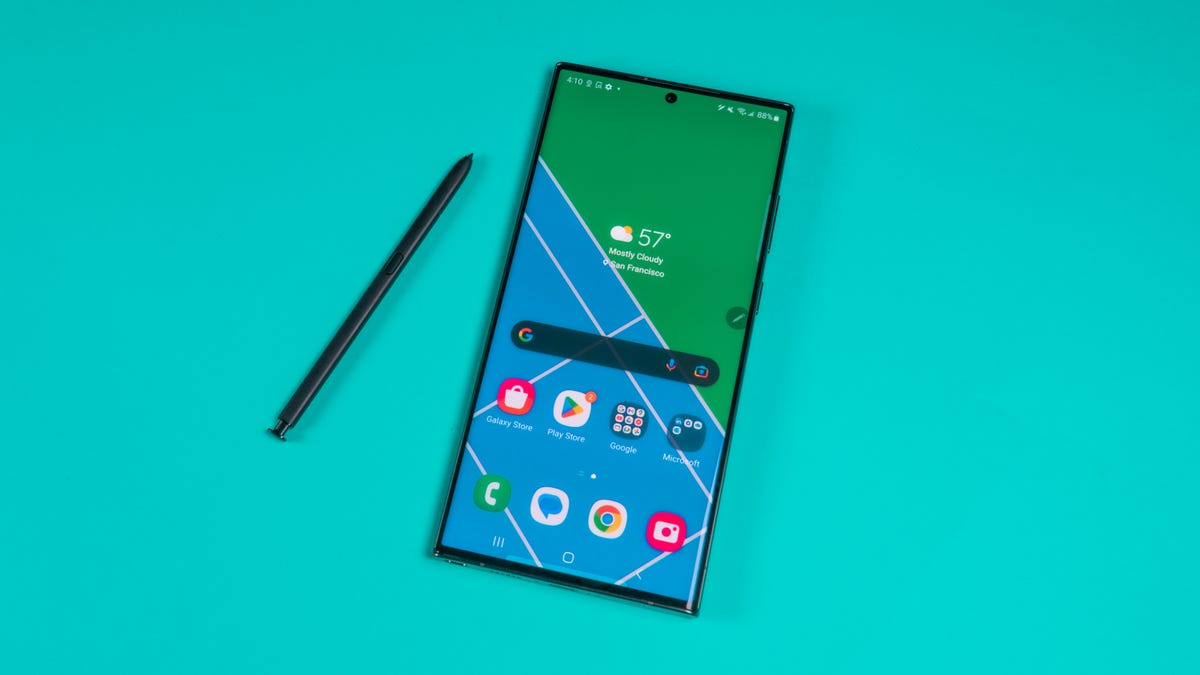

The S Pen returns on the Galaxy S23 Ultra.
James Martin/CNETThe in-screen fingerprint reader was a favorite feature of mine on my Galaxy phones, and it’s nice to have that option again while using the Ultra. I missed it when I first switched to the iPhone, but Face ID is solid enough that I quickly got over it. Unlocking both phones has been seamless.
The Galaxy S23 Ultra’s price is the same as the iPhone
The S23 Ultra is $1,200 for 256 GB of storage and is priced similarly to the iPhone 14 Pro Max with the same amount of storage. The smaller iPhone 14 Pro is $1,100 for 256GB. Whether you’re a Galaxy fan or an iPhone lover, $1,200 is a lot. But in this case, you get what you pay for.
Galaxy S23 Ultra vs. iPhone 14 Pro final thoughts


Those camera bumps on the iPhone 14 Pro feel a little excessive.
John Kim/CNETIt’s been fun to revisit a world I’ve abandoned and compare the iPhone I have now to the one I could’ve had if I’d stayed in the Galaxy family. While there are aspects to the S23 Ultra that I appreciate, like brighter and more colorful images, better video stabilization and incredible battery life, there are advantages to having an iPhone that go beyond specs that’ll likely keep me in the Apple ecosystem for a while. Features like Airdrop and iMessage have made the user experience more seamless. And I don’t know if I could give up the iPhone’s video quality for anything else.
Still, I know that if I want to take a picture that makes people’s jaws drop, I’ll likely reach for the S23 Ultra. Then I’ll wait for the look of shock when I tell them it wasn’t taken with an iPhone.
Check out the video above to see more of my experience trying out these two phones, along with some side-by-side examples of photos and videos taken on each.
Technologies
Judge Blocks Texas App Store Age-Check Law
A preliminary injunction found the Texas law, set to begin Jan. 1, is «more likely than not unconstitutional.»

A new Texas state law set to take effect on Jan. 1 would have required app stores to implement age verification processes. But the law has been put on hold, at least temporarily, by a federal court judge.
As reported by the Texas Tribune, Senate Bill 2420, also known as the Texas App Store Accountability Act, is the subject of a temporary injunction issued by US District Judge Robert Pitman.
Pitman said in his decision that the law as written is broad, vague and «more likely than not unconstitutional.» However, he also wrote the court «recognizes the importance of ongoing efforts to better safeguard children when they are on their devices.»
Don’t miss any of our unbiased tech content and lab-based reviews. Add CNET as a preferred Google source.
The Texas law, signed into law by Governor Greg Abbott in May, requires app store operators — including Apple, Google, Nintendo, Steam and more — to build age verification processes for the storefronts and to only allow downloads to minors who obtain parental consent. The injunction is a ruling in an October lawsuit filed by the Computer & Communication Industry Association.
CCIA senior vice president Stephanie Joyce said in a statement, «This Order stops the Texas App Store Accountability Act from taking effect in order to preserve the First Amendment rights of app stores, app developers, parents, and younger internet users. It also protects parents’ inviolate right to use their own judgment in safeguarding their children online using the myriad tools our members provide.»
Other individuals and the advocacy group Students Engaged in Advancing Texas also filed suits over the law, the Texas Tribune reported.
App Store Accountability Act
The bill author, State Senator Angela Paxton, said the bill was meant to give parents «common sense tools to protect their kids and to survive court challenges by those who may have lesser priorities.»
The language of Texas Senate Bill 2420 does not only include mobile app stores from Apple or Google, but any «website, software application, or other electronic service that distributes software applications from the owner or developer of a software application to the user of a mobile device.»
By that definition, websites with links to browser games or mobile game consoles with download options would fall under the Texas law as written. The law also defines mobile devices as including phones and tablets, as well as any other handheld device capable of transmitting or storing information wirelessly.
The parental consent aspect of the law requires those under 18 to have an app store account affiliated with a parent or guardian to purchase or download applications.
Age verification elsewhere
In an effort to keep adult materials out of reach of minors and to protect children from potentially harmful content and interactions, tech companies have been compelled by law or through legal action to verify the age of users.
Roblox, which has a huge audience of minors, began rolling out stricter age verification after investigations and lawsuits hurt its reputation as a safe gaming space. Australia is perhaps the most large-scale example of a government restricting access to online content. In December, Australia began restricting social media access to those 16 and older. Reddit recently challenged that law.
In the US, age verification laws have primarily targeted adult sites. Texas already has a law on the books that requires adult sites to age-block their content. The Supreme Court upheld that law in a June ruling. The UK has also enacted age restriction rules for adult sites as have other US states.
Technologies
Today’s NYT Mini Crossword Answers for Thursday, Dec. 25
Here are the answers for The New York Times Mini Crossword for Dec. 25.

Looking for the most recent Mini Crossword answer? Click here for today’s Mini Crossword hints, as well as our daily answers and hints for The New York Times Wordle, Strands, Connections and Connections: Sports Edition puzzles.
Need some help with today’s Mini Crossword? Of course, there’s a very Christmassy clue involved. And once you solve the entire puzzle, look at the letters used in all the answers and see what they have in common. (5-Across will tell you!) Read on for all the answers. And if you could use some hints and guidance for daily solving, check out our Mini Crossword tips.
If you’re looking for today’s Wordle, Connections, Connections: Sports Edition and Strands answers, you can visit CNET’s NYT puzzle hints page.
Read more: Tips and Tricks for Solving The New York Times Mini Crossword
Let’s get to those Mini Crossword clues and answers.
Mini across clues and answers
1A clue: ___ King Cole, singer with the album «The Magic of Christmas»
Answer: NAT
4A clue: Body drawings, informally
Answer: TATS
5A clue: Letters to ___ (what this Mini was made with)
Answer: SANTA
6A clue: Huge fan, in slang
Answer: STAN
7A clue: «Illmatic» rapper
Answer: NAS
Mini down clues and answers
1D clue: Grandmothers, by another name
Answer: NANAS
2D clue: Abbr. before a name on a memo
Answer: ATTN
3D clue: Org. with long lines around the holidays
Answer: TSA
4D clue: «See ya later!»
Answer: TATA
5D clue: Govt.-issued ID
Answer: SSN
Don’t miss any of our unbiased tech content and lab-based reviews. Add CNET as a preferred Google source.
Technologies
Don’t Let a Border Agent Ruin Your Holiday Trip. Travel With a Burner Phone
Yes, you should leave your main phone at home and take a cheap burner this winter.

Prepare for a whole new level of border-crossing anxiety this holiday season: the high-probability of a phone search. New figures from US Customs and Border Protection say agents aren’t just glancing at your lock screen anymore — they are aggressively ramping up device inspections, even for citizens coming home. We aren’t just talking about a quick scroll through your photos, either. Agents are increasingly using forensic tools to clone and analyze everything on your device.
The stats are genuinely alarming. In just a three-month window this year, nearly 15,000 devices were flagged for searches, with over a thousand subjected to deep-dive data copying. If you’re traveling with your primary phone, you are essentially carrying your entire digital existence into a legal gray zone where privacy is optional.
The smartest defensive play is remarkably low-tech: the burner phone. By traveling with a secondary, stripped-down device, you ensure your private data stays safe at home while you stay connected abroad. But privacy isn’t the only perk. Moving to a «dumb» phone is the ultimate digital detox, helping you escape the notification trap that usually ruins a vacation.
Even figures like Conan O’Brien have ditched the smartphone to cut through the noise. Whether you’re dodging invasive border searches or just trying to enjoy your trip without being glued to a screen, a burner might be the best travel investment you make this year.
Read more: Best Prepaid Phone of 2025
Although carriers have offered prepaid phones since the ’90s, «burner phones» or «burners» became popular in the 2000s following the celebrated HBO series The Wire, where they helped characters avoid getting caught by the police. Although often portrayed in that light, burners aren’t only used by criminals; they’re also used anyone concerned with surveillance or privacy infringement.
What is a burner phone, and how does it work? Here’s everything you need to know about burners and how to get one.
Don’t miss any of our unbiased tech content and lab-based reviews. Add CNET as a preferred Google source.
What is a burner phone?
A burner phone is a cheap prepaid phone with no commitments. It comes with a set number of prepaid call minutes, text messages or data, and it’s designed to be disposed of after use.
Burner phones are typically used when you need a phone quickly, without intentions of long-term use. They’re contract-free, and you can grab them off the counter. They’re called burner phones because you can «burn» them (trash them) after use, and the phone can’t be traced back to you, which makes them appealing to criminals. Of course, those committed to illicit activities often do more than just throw these phones in the trash, and often completely obliterate the SIM cards and other materials by smashing them with a hammer or melting them away.
Burners are different from getting a regular, contract-bound cellphone plan that requires your information to be on file.
Why should you use a burner phone?
Burner phones are an easy way to avoid cellphone contracts or spam that you get on your primary phone number. Burners aren’t linked to your identity, so you can avoid being tracked down or contacted.
You don’t have to dispose of a burner phone after use. You can add more minutes and continue using it. Burner phones can still function as regular phones, minus the hassle of a contract.
You can also get a burner phone as a secondary phone for a specific purpose, like having a spare phone number for two-factor authentication texts, for business or to avoid roaming charges while traveling. Burner phones are often used by anyone concerned with privacy.
Read more: The Data Privacy Tips Digital Security Experts Wish You Knew
Burner phones, prepaid phones, smartphones and burner SIMs: What’s the difference?
Burner phones are cheap phones with simple designs that lack the bells and whistles of a smartphone. Because they’re designed to be disposable, you only get the essentials, as seen by the most common version, the flip phone.
All burner phones are prepaid phones, but not all prepaid phones are burners. What sets a burner apart is that you won’t have to give away any personal information to get one, and it won’t be traceable back to you. Again, a burner phone is cheap enough to be destroyed after use.
Prepaid smartphones are generally low-end models. You can use any unlocked smartphone with prepaid SIM cards, essentially making it a prepaid phone.
If you want a burner, you don’t necessarily have to buy a new phone. You can get a burner SIM and use it with an existing phone. Burner SIMs are prepaid SIMs you can get without a contract or giving away personal information.
Where can you buy a burner phone?
Burner phones are available at all major retail outlets, including Best Buy, Target and Walmart. They’re also often available at convenience stores like 7-Eleven, local supermarkets, gas stations and retail phone outlets like Cricket and Metro.
You can get a burner phone with cash, and it should cost between $10 and $50, although it may cost more if you get more minutes and data. If you’re getting a burner phone specifically to avoid having the phone traced back to you, it makes sense to pay with cash instead of a credit card.
If you just want a prepaid secondary phone, you can use a credit card. Just keep in mind that credit cards leave a trail that leads back to you.
There are also many apps that let you get secondary phone numbers, including Google Fi and the Burner app. However, these aren’t burners necessarily because the providers typically have at least some of your personal information. Additionally, apps like Google Talk require a phone number that’s already in use for you to choose a number with the service.
If you’re just looking to get a solid prepaid phone without anonymity, check out our full guide for the best prepaid phone plans available. We also have a guide for the best cheap phone plans.
-

 Technologies3 года ago
Technologies3 года agoTech Companies Need to Be Held Accountable for Security, Experts Say
-

 Technologies3 года ago
Technologies3 года agoBest Handheld Game Console in 2023
-

 Technologies3 года ago
Technologies3 года agoTighten Up Your VR Game With the Best Head Straps for Quest 2
-

 Technologies4 года ago
Technologies4 года agoBlack Friday 2021: The best deals on TVs, headphones, kitchenware, and more
-

 Technologies4 года ago
Technologies4 года agoVerum, Wickr and Threema: next generation secured messengers
-

 Technologies4 года ago
Technologies4 года agoGoogle to require vaccinations as Silicon Valley rethinks return-to-office policies
-

 Technologies4 года ago
Technologies4 года agoOlivia Harlan Dekker for Verum Messenger
-

 Technologies4 года ago
Technologies4 года agoiPhone 13 event: How to watch Apple’s big announcement tomorrow





